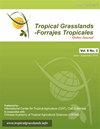用两种不同的选择方法提高色堇(Panicum coloratum var. coloratum)群体耐盐性的前瞻性遗传增益
IF 0.7
4区 农林科学
Q3 AGRICULTURE, DAIRY & ANIMAL SCIENCE
引用次数: 2
摘要
花冠草(Panicum coloratum变种。coloratum)是一种亚热带草本植物,在养牛活动已迁移的低生产力环境中有可能增加饲料产量。估计了盐胁迫和非盐胁迫下耐盐性状的遗传力,探讨了通过选择提高耐盐能力的可能性。从一个在非常恶劣的环境中收集的基础种质中,用2个重组单位:个体和表型家族平均(PFM)计算选择后的遗传力和增益。在盐水和非盐水条件下,所有性状的遗传力估计都很低,表明耐盐性的遗传控制很复杂,非加性遗传效应占很大比例。个体选择的估计值高于PFM,个体选择的预期遗传收益更高。在盐水和非盐水条件下进行比较,预测平均值大于cv。克莱因,最常用的品种。结果表明,所分析的种质资源可作为提高色兰耐盐性的重要基因来源。本文章由计算机程序翻译,如有差异,请以英文原文为准。
Prospective genetic gain to improve salinity tolerance in a population of Panicum coloratum var. coloratum with two different selection methods
Panicum coloratum var. coloratum is a subtropical grass for potentially increasing forage production in lowly productive environments where cattle-raising activities have been relocated. Heritability was estimated for characters related to salinity tolerance under saline and non-saline conditions to explore the possibility of improving tolerance by selection. From a base germplasm collected in a very harsh environment, heritability and gain after selection were calculated using 2 recombination units: individual and phenotypic family mean (PFM). Heritability estimates were very low for all characters both in saline and non-saline conditions, suggesting a complex genetic control of salinity tolerance, with a high proportion of non-additive genetic effects. Estimates were higher using individual selection than with PFM and expected genetic gains were higher for individual selection. When compared in both saline and non-saline conditions, predicted means were greater than for plants of cv. Klein, the most common cultivar in use. It appears that the analyzed germplasm would be a valuable source of genes to be included in breeding programs to increase salinity tolerance in Panicum coloratum.
求助全文
通过发布文献求助,成功后即可免费获取论文全文。
去求助
来源期刊

Tropical Grasslands-Forrajes Tropicales
Agricultural and Biological Sciences-Agronomy and Crop Science
CiteScore
1.60
自引率
0.00%
发文量
36
审稿时长
16 weeks
期刊介绍:
The Journal publishes, in English or Spanish, Research Papers and Short Communications on research and development, as well as contributions from practitioners (Farmer Contributions) and Review Articles, related to pastures and forages in the tropics and subtropics. There is no regional focus; the information published should be of interest to a wide readership, encomprising researchers, academics, students, technicians, development workers and farmers.
In general, the focus of the Journal is more on sown (''improved'') pastures and forages than on rangeland-specific aspects of natural grasslands, but exceptions are possible (e.g. when a submission is relevant for a particularly broad readership in the pasture and forage science community).
The Journal will also consider the occasional publication of associated, but closely related, research in the form of an additional scientific communication platform [e.g. a re-make of the former Genetic Resources Communication series of the former Division of Tropical Crops and Pastures of the Commonwealth Scientific and Industrial Research Organisation (CSIRO), Australia].
Areas of particular interest to the Journal are:
Forage Genetic Resources and Livestock Production[...]
Environmental Functions of Forages[...]
Socio-economic Aspects[...]
Topics within the aforementioned areas may include: Diversity evaluation; Agronomy; Establishment (including fertilization); Management and utilization; Animal production; Nutritive value; Biotic stresses (pests and diseases, weeds); Abiotic stresses (soil fertility, water, temperature); Genetics and breeding; Biogeography and germplasm collections; Seed production; Ecology; Physiology; Rhizobiology (including BNF, BNI, mycorrhizae); Forage conservation; Economics; Multilocational experimentation; Modelling.
 求助内容:
求助内容: 应助结果提醒方式:
应助结果提醒方式:


